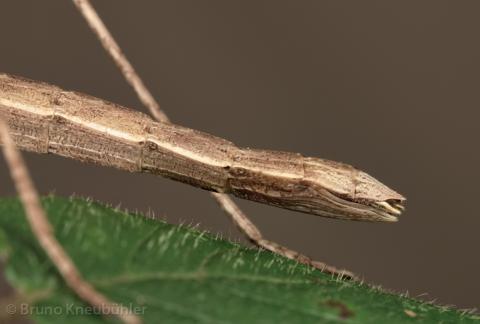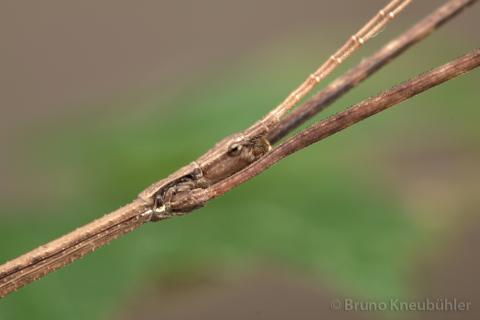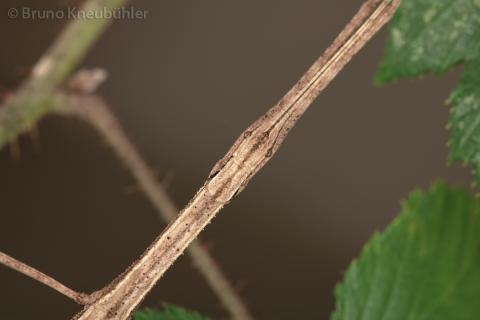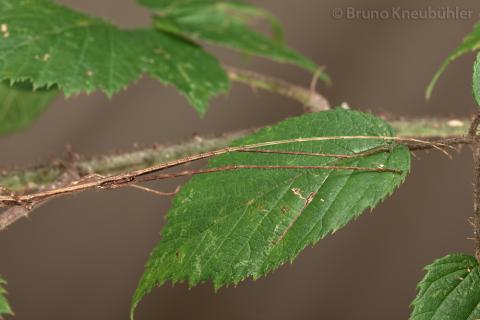
Genus
Species
Stock
CLP
596
Culture status
Unknown
Foodplants
Bramble (Rubus spp.)
Breeding notes
(by Bruno Kneubühler)
General Notes
- the genus Acacus has been set up by Brunner v. Wattenwyl
- the type species for this genus is Bacteria sarawaca (= Acacus sarawacus) Westwood 1859
- this species is momentarily under taxonomical examination
Origin
- Mt. Sibayak near Brastagi (nothern Sumatra)
Females
- inconspicuous, typical phasmids
- about 7 cm long
- coloration is rather variable between amongst females
- different brown shades
- many small tubercles, especially on the dorsal thorax area
- antennae longer than fore legs
- small, faintly yellowish wing rudiments
Males
- thin phasmids
- about 5.5 – 6 cm long
- several small tubercles, especially on the dorsal thorax area
- different brown shades
- coloration is rather consistent amongst males
- antennae longer than fore legs
- small, faintly yellowish wing rudiments
Nymphs
- L1 nymphs are about 17 mm long
- a light band near the antennae tips
- antennae longer than fore legs
- dark knees
- in L3 it is possible to distinguish male and female nymphs
Eggs
- about 4 x 1.5 mm
- elongate, conical (which is very typical for this genus)
- brown
- matt
- image of the (similar) egg of Acacus braggi
Food Plants
- freshly hatched nymphs accept bramble (Rubus sp.) easily
- also older nymphs and adults feed well on bramble (Rubus sp.)
Behaviour
- nymphs as well as adult specimens show no active defensive behaviour. When the feel threatened, then they just freeze and rely on their camouflage
- thus it is a rather calm species
- females start laying eggs about 3 weeks after their final moult
- they lay about 8 – 10 eggs per week
- females will stick some eggs into cracks (e.g. bark), most mostly they just let the eggs drop to the ground. Eggs were not stuck into sand
- matings can be observed regularely during the night, they last for some hours at the most
Developement
- incubation time is about 5 months
- hatching ratio in F1 was high (50+ %)
- males will be adult after about 3 months (at 20 – 25°C), females after about 4 months
Breeding Notes
- an easy to keep species
- incubation with the Cup-Incubation-Method (on slightly humid vermiculite at 20 – 23°C) yields good hatching results
- spread some dry moss over the eggs, this will make it much easier for the nymphs to hatch properly
- keep the nymphs in a cage with good ventilation, but take care that the humidity does not drop too low
- a constantly wet paper towel on the floor of the cage helps raising humidity
- nymphs can be kept in a Faunabox (or similar cages)
- move nymphs to a bigger cage as they grow bigger
- I have never sprayed nymphs or adults with water
- make shure that nymphs, which are about to undergo their adult moult, do not find places in the cage which would not offer them enough space beneath to moult successfully
Some basics of phasmid breeding
- our detailed notes on how to successfully breed phasmids are an integral part of this care sheet
- keep just one species per cage
- use the full and correct culture name with provenience affix in brackets, yet never use common names. For example Trychopeplus laciniatus "Monteverde", but not "mossy mountain phasmid". This supports the serious breeder's efforts to keep cultures pure. Informations on why and how to keep cultures seperate and pure
- try to keep (day) temperatures below 28°C, while a nocturnal temperature drop is natural and advisable
- do not spray too often, phasmids are no fish































